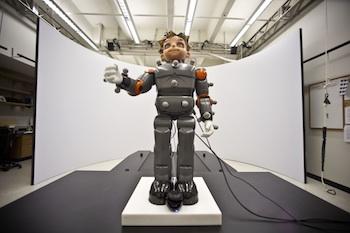Video: Humanoid Robot Used to Treat Autism
by Bio, designnews.comAugust 13th 2012
Children with autism struggle to relate directly to other people. But what happens when they interact with a child-sized robot that has an expressive human face but isn't limited by emotional reactions to their struggles?
Researchers at the University of Texas Arlington (UTA) are working with the Dallas Autism Treatment Center to find out through Zeno, a robot that has been tested with patients to help them develop more appropriate responses to everyday social interactions.
"Autism seems to be a good application for these kind of robots, because autistic kids have a hard time relating to adults, but they seem to be very interested in interacting with robots," Dan Popa, a UTA associate professor of electrical engineering and a lead investigator on the research, told us.

Hanson Robotics designed Zeno, whose face moves in a way similar to human faces. Zeno's face is made of an innovative compliant polymer called "flubber" that offers the look and feel of human skin. Popa said motors behind the face push and pull certain points on the material to create up to 10 different facial expressions.
"Zeno has an incredible face," said Carolyn Garver, director of the Dallas Autism Treatment Center, who has worked there with autistic people for 33 years and has used Zeno with her patients. "It feels real."
Garver has collaborated with UTA on feasibility tests with both autistic children and adults to determine if Zeno can be used to help people with autism identify different emotions and feelings. This, in turn, might help them begin identifying those emotions in people -- a fundamental social disability for autistic people.
The robot can interact with patients the way humans do, but it isn't limited by the emotional responses human therapists may have during treatment. There is an element of make-believe about Zeno that ties into the fantasy world "many of these children live in anyway," Garver said. "They don't identify with people very well. The robot is like a bridge. They respond to Zeno. He's nonjudgmental. He doesn't get mad. He can do the same thing over and over again, and he doesn't get tired."
Original Page: http://www.designnews.com/document.asp?doc_id=248880&f_src=designnews_gnews&dfpPParams=ind_182,industry_medical,aid_248880&dfpLayout=article&dfpPParams=ind_182,industry_medical,aid_248880&dfpLayout=article
Shared from Read It Later
Comments
Post a Comment